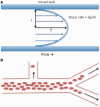Cerebral malaria in children: using the retina to study the brain
- PMID: 24578549
- PMCID: PMC4107732
- DOI: 10.1093/brain/awu001
Cerebral malaria in children: using the retina to study the brain
Abstract
Cerebral malaria is a dangerous complication of Plasmodium falciparum infection, which takes a devastating toll on children in sub-Saharan Africa. Although autopsy studies have improved understanding of cerebral malaria pathology in fatal cases, information about in vivo neurovascular pathogenesis is scarce because brain tissue is inaccessible in life. Surrogate markers may provide insight into pathogenesis and thereby facilitate clinical studies with the ultimate aim of improving the treatment and prognosis of cerebral malaria. The retina is an attractive source of potential surrogate markers for paediatric cerebral malaria because, in this condition, the retina seems to sustain microvascular damage similar to that of the brain. In paediatric cerebral malaria a combination of retinal signs correlates, in fatal cases, with the severity of brain pathology, and has diagnostic and prognostic significance. Unlike the brain, the retina is accessible to high-resolution, non-invasive imaging. We aimed to determine the extent to which paediatric malarial retinopathy reflects cerebrovascular damage by reviewing the literature to compare retinal and cerebral manifestations of retinopathy-positive paediatric cerebral malaria. We then compared retina and brain in terms of anatomical and physiological features that could help to account for similarities and differences in vascular pathology. These comparisons address the question of whether it is biologically plausible to draw conclusions about unseen cerebral vascular pathogenesis from the visible retinal vasculature in retinopathy-positive paediatric cerebral malaria. Our work addresses an important cause of death and neurodisability in sub-Saharan Africa. We critically appraise evidence for associations between retina and brain neurovasculature in health and disease, and in the process we develop new hypotheses about why these vascular beds are susceptible to sequestration of parasitized erythrocytes.
Keywords: cerebral malaria; cerebral microvasculature; haemorheology; retinal microvasculature; surrogate marker.
© The Author (2014). Published by Oxford University Press on behalf of the Guarantors of Brain.
Figures




Comment in
-
Reply: Retinopathy, histidine-rich protein-2 and perfusion pressure in cerebral malaria.Brain. 2014 Sep;137(Pt 9):e299. doi: 10.1093/brain/awu146. Epub 2014 Jun 11. Brain. 2014. PMID: 24919966 Free PMC article. No abstract available.
-
Retinopathy, histidine-rich protein-2 and perfusion pressure in cerebral malaria.Brain. 2014 Sep;137(Pt 9):e298. doi: 10.1093/brain/awu144. Epub 2014 Jun 11. Brain. 2014. PMID: 24919968 Free PMC article. No abstract available.
References
-
- Agrawal A, McKibbin MA. Purtscher’s and Purtscher-like retinopathies: a review [Review] Surv Ophthalmol. 2006;51:129–36. - PubMed
-
- Akima M. A morphological study on the microcirculation of the central nervous system. Selective vulnerability to hypoxia. Neuropathology. 1993;13:99–112.
-
- Alm A, Bill A. Ocular and optic nerve blood flow at normal and increased intraocular pressures in monkeys (Macaca irus): a study with radioactively labelled microspheres including flow determinations in brain and some other tissues. Exp Eye Res. 1973;15:15–29. - PubMed
-
- An H, Lin W. Cerebral venous and arterial blood volumes can be estimated separately in humans using magnetic resonance imaging. Magn Reson Med. 2002;48:583–8. - PubMed
Publication types
MeSH terms
Substances
Grants and funding
LinkOut - more resources
Full Text Sources
Other Literature Sources

